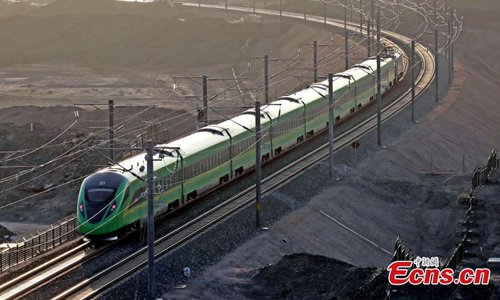HOME >> CHINA
Nation’s high-speed rail to go intelligent
By Zhang Hongpei Source:Global Times Published: 2019/10/25 20:28:40

A Fuxing bullet train crosses the Hongliu River Bridge between the border of Gansu Province and Xinjiang Uygur Autonomous Region, July 28, 2019. It is one of the first two Fuxing bullet trains to be used in Xinjiang. Entirely designed and manufactured in China, the Fuxing, or Rejuvenation, trains are more spacious and energy-efficient, with a longer service life and better reliability than previous models. (Photo: China News Service/Cai Zengle)
China's high-speed rail (HSR) has taken strides over the past decades, realizing self-control and innovation in research and development (R&D), and will continue to ramp up efforts and share its experience with the rest of the world, front-line engineers and industry analysts said.
At a press conference on Friday, five engineers working on the front line of China's HSR networks shared their experience in major HSR projects, including the Fuxing bullet train and Beijing-Zhangjiakou high-speed railway.
Through years of research and innovation, China's HSR has become a leader thanks to rapid development, large-scale construction and huge transport capacity, with technologies among the most advanced in the world - some even leading the world.
Mo Zhisong, director of the signaling division at China Railway Corp, cited the train control system as an example. He said China's HSR control system, a crucial part of the train's safe operation, underwent three major phases: introducing technologies from France two decades ago; adopting joint designs of domestic and foreign firms while using the Chinese standard for the first time a decade ago; realizing a home-grown control system from hardware to software and to operating system since last year.
"It is inevitable to work out a China solution based on the country's real situation. There was no standard or equipment in the world that could fully fit into China," Mo said.
"I still remember when the Beijing-Tianjin high-speed train was opened in 2008. Our staff was afraid of encountering bad whether like snow because snow at the bottom of the train would affect its radar," Mo noted.
"We have since developed a mature control system to ensure the high-speed train's safe operation regardless of snow, sand and wind, or a salty environment by the sea," he added.
The Beijing-Tianjin line is China's first high-speed railway line. Running at over 300 kilometers per hour, it takes 35 minutes from the capital city to North China's Tianjin Municipality.
The most-expected Beijing-Zhangjiakou high-speed railway, the world's first smart rail line, will run at speeds of up to 350 kilometers per hour and use cutting-edge technologies. It is expected to be put in operation by the end of the year.
Linking Beijing and Zhangjiakou, North China's Hebei Province that will stage most of the skiing events at the 2022 Winter Olympic Games, the line will be defined by intelligence. "It has 67 intelligence-related projects, including autonomous driving and smart maintenance," said Mo.
Deep fusion with digitalization and intelligence, as well as the application of green equipment and materials are the future trend of China's HSR, said Yang Bin, who is the construction director of the Beijing-Xiongan intercity railway. The Beijing section of the intercity railway linking Beijing with Xiongan New Area was opened on September 26.
By the end of 2018, China's HSR had exceeded 29,000 kilometers, accounting for more than 66.3 percent of the world's total, according to China Railway Corp.
The country's HSR development plan says that by 2020, China's high-speed rail is expected to reach 30,000 kilometers, covering 80 percent of major cities.
China should be confident and flexible in exporting its experience, to seek common interests for both sides, Xu Liping, director of the Center for Southeast Asian Studies at the Chinese Academy of Social Sciences, told the Global Times Friday.
Construction of the Jakarta-Bandung high-speed railway is making progress, Wang Changjin, the deputy chief engineer of the China Railway Design Corp, told the press conference.
At the start of 2016, Indonesia broke ground on the 142.3 kilometer railway, a landmark project along the sea route of the China-proposed Belt and Road Initiative. The rail project was about 25 percent done, the Global Times reported in July.
"How to localize technologies and train local workers toward Chinese HSR standards are key to expanding Chinese rail technologies overseas," said Xu.
RELATED ARTICLES:
Posted in: SOCIETY,CHINA FOCUS